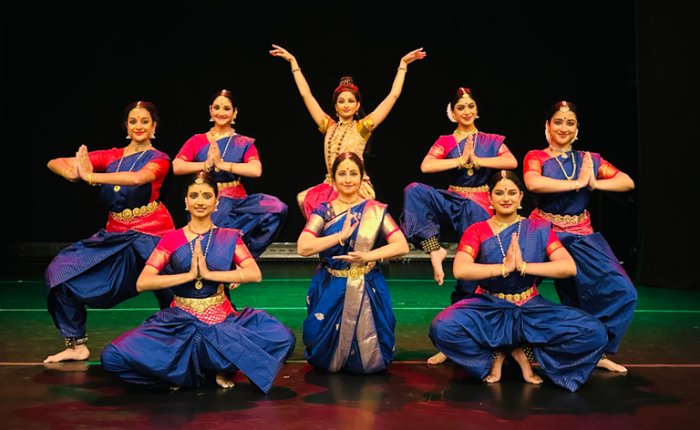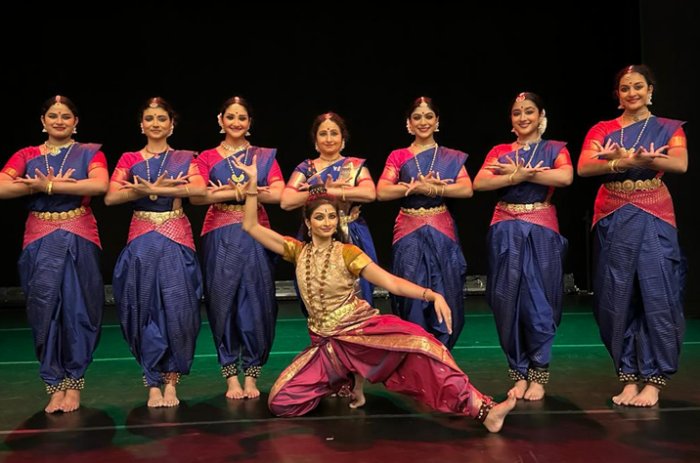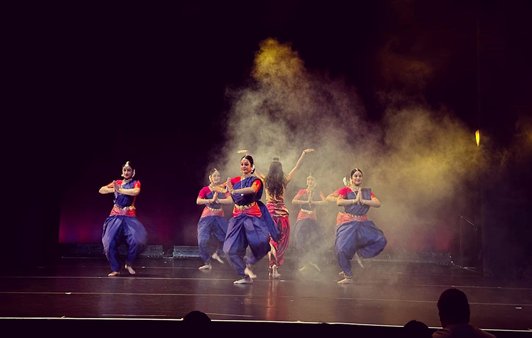
|
 |

|
 |
Sujatha Srinivasan on 'Samayam - A moment in eternity' - Dr. Ganga Lakshmi Srinivas e-mail: gangalakshmi@gmail.com August 17, 2023 Embarking on her ongoing exploration of abstract themes, Guru Sujatha Srinivasan once again interweaves Vedic concepts with contemporary realities in the long-awaited production of 'Samayam - A Moment in Eternity.' This captivating performance, delayed due to the pandemic, graces the Gordon Square Theatre in Cleveland's vibrant Gordon Square Art district in early May. Shri Kalaa Mandir-Center for Indian Performing Arts was poised to present this production as a double bill with Morrison Dance in April 2020, becoming an early casualty of the pandemic response. Cleveland Public Theatre responded by featuring several dance troupes to reignite public engagement through its DanceWorks series of weekend shows. Exploring the concept of Time, Sujatha and her daughter Shriya ingeniously employ adavus' symmetry and the concept of kaalam to depict the second, minute, and hour hands of a clock. Sujatha shares insights about this intriguing production.  Why the theme of Time? The idea of exploring Time has lingered since the 1990s, given its immense relevance to our daily lives. My initial vision was to illuminate the activities unfolding between sunrise and sunset. Over time, this concept evolved into a broader exploration. In this production, I aimed to portray the passage of time as perceived by individuals based on their emotional states or circumstances. It was crucial for the audience to connect with this concept. Time exerts a profound influence on our lives. Juggling commitments, moving at a frenzied pace, we often sense its scarcity. Moments of existential reflection frequently arise from the ticking of time. Indeed, change remains constant, and our challenge is to embrace the present. How did this opportunity arise? Cleveland Public Theatre annually commissions new works, offering artistes boundless creative freedom upon selection by the judging panel. This latitude empowers us to undertake creative risks. In our inaugural production for CPT in 2019, 'Vivarta,' we approached climate change through the traditional language of Bharatanatyam and achieved a sold-out run on all three nights. In our second production, we delved into the theme of Time. The gratification arises from the audience's appetite for novel content and their openness to fresh ideas. Anchoring your production is a Vedic verse about Time. What prompted its selection? Punaḥ Prabhātaṁ Punareva Śarvarī Punaḥ Śaśāṅkaḥ Punarūdyate Raviḥ. Kālasya Kiṁ Gachchati Yāti Yauvanaṁ Tathāpi Lokaḥ Kathitaṁ Na Budhyate. (Translation): Morning again, night again, moon again, sunrise again and again Where does time go? Youth certainly goes. Even then, people do not realize! We often consider change solely from a personal perspective - I was young, and now I'm older. However, we overlook the larger context: that time itself is both changing and constant. Time, as an unerring observer, remains a witness to everything, including creation. My concept frames human experience within the context of passing through days and progressing into tomorrows. If we could journey back in time, our past experiences would remain intact. Our present-day concept of time - yesterday, today, and tomorrow - stems from our measurements. You've incorporated the theme of romantic love twice - once in new choreography and once in a traditional padam (Netru varen endru). Why this facet of experience? Deliberately, we spotlight the way time is perceived through human experiences. For instance, when a child visits home, the time together seems fleeting, and before we know it, it's time to return to the airport. Other encounters may appear to stretch endlessly. Thus, we choreographed a scene where lovers meet, transcending time's boundaries to experience a fleeting eternity. Conversely, in the traditional padam, the experience of separation seems unending. How did you select the music, including that of Anoushka Shankar? Alarippu's music and sollukattu were aptly suited for our first scene, portraying physical time within a day. The raga Chakravakam by Ranjani and Gayatri resonated fittingly with our theme of love. For our depiction of Shiva as Kaal (Time), Anoushka Shankar's music provided a compelling foundation to accentuate the choreography. It harmonized with my intuition and proved a robust finale.  Which choreographic piece was particularly exciting for you on stage? It's challenging to pick a single favorite. The Alarippu segment, displaying a clock and illustrating a day in a person's life, is both relatively simple and highly intricate. It encompasses myriad facets of an individual's journey. The second piece portrays an entire lifetime. It demanded thoughtful stage utilization and lighting to depict a day's passage while unveiling the main character's inner turmoil explicitly. What moment on stage precisely captured your intended message? As I was performing, I couldn't personally witness it, but from the feedback received, the audience grasped the essence of Alarippu. Many non-Indians resonated with the traditional padam, surprising me. I was initially unsure about including such a traditional piece and whether it would resonate or require patience. However, it resonated deeply with diverse individuals; even other dancers from various companies expressed their connection to its portrayal of a woman betrayed by her lover. How did the collaboration with Ami Majmudar come about, and how has it impacted your productions? Ami Majmudar, my student since 2002, initially narrated for a production called 'Minstrels of God.' This event, a fundraiser for the Shiva-Vishnu temple, featured her as Narada, weaving together the concept of five types of Bhakti (devotion). As a novelist, she possesses a unique way with words. Our collaboration began as we explored abstract themes. Her distinctive style aids us in crafting narration that enables the audience to better understand, relate to, and contemplate the movement's narrative. We strive for audiences to not merely witness a performance but to digest its content, reflect on their own life experiences, and respond to the calls to action woven into our work. Ami's compelling narration enhances our mission.  Your production employs various recorded recordings. What advice can you offer to other dancers or troupes concerning sound quality in professional venues? While a live orchestra is preferable, constraints such as cost and scheduling often lead creators to recorded music. Ensuring high audio quality and consistency throughout the show is pivotal to delivering a coherent experience. Fortunately, contemporary technology enables achieving this effectively.  Dr. Ganga Lakshmi Srinivas is a practicing pediatrician in Cleveland, Ohio. Her love for the Indian performing arts began in childhood growing up in a family that reveres music, and has continued to be nurtured in the rich landscape of tenacious teachers and performers who keep traditional arts thriving in the United States. Post your comments Please provide your name and email id when you use the Anonymous / blog profiles to post a comment. All appropriate comments posted with name and email id in the blog will be featured in the site. |